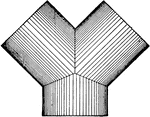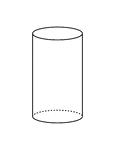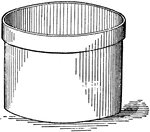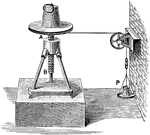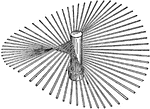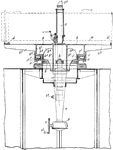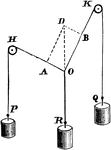3 Similar Cylinders
Illustration of 3 similar cylinders. The height and diameter in each successively smaller cylinder is…

3 Smaller Cylinders In A Larger Cylinder
A large cylinder containing 3 smaller congruent cylinders. The small cylinders are externally tangent…

4 Congruent Tangent Right Circular Cylinders
Illustration of 4 congruent tangent right circular cylinders. The height of all the cylinders is greater…
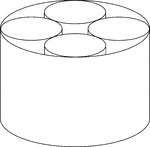
4 Smaller Cylinders In A Larger Cylinder
A large cylinder containing 4 smaller congruent cylinders. The small cylinders are externally tangent…

4 Tangent Cylinders
Illustration of 4 congruent cylinders with diameters less than the height. The cylinders are externally…
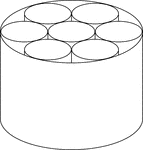
7 Smaller Cylinders In A Larger Cylinder
A large cylinder containing 7 smaller congruent cylinders. The small cylinders are externally tangent…

7 Tangent Cylinders
Illustration of 7 congruent cylinders with diameters less than the height. 6 of the cylinders are equally…
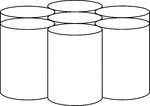
7 Tangent Cylinders
Illustration of 7 congruent cylinders with diameters less than the height. 6 of the cylinders are equally…

Danglish Apparatus
"The Danglish apparatus consists of the following parts: 1st, a generator A, in which carbonic acid…

Deleuil's Air-pump
"To avoid friction and heat, the piston is not in contact with the cylinder in which it works."
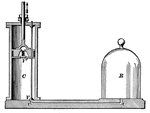
Pneumatic Devices
An air pump, which removes air from an enclosed space. R is the receiver and space that it encloses…

Double-acting Cylinder
"The first alteration to be noticed in the double-acting engine is that of the cylinder. To insure its…

Double-acting Cylinder
"The first alteration to be noticed in the double-acting engine is that of the cylinder. To insure its…

Forcing-Pump
"In the forcing-pump atmospheric pressure plays but a small part. There is no valve in the piston c,…

Glass Cutter
"Now the splitting is done with a diamond cutter fixed in the fleft of a stick and guided from end to…

Glass Cutter
"In the arrangement of the flattening and annealing ovens numerous improvements have been effected,…
Conventional Breaks Symbols of Pipe or Tubing by Cutting Diameter
The conventional break symbol for drawing a pipe or tubing by cutting the diameter in half.

High-Tension Ignition System
Diagram of a high-tension ignition system. A is the source of current, usually a batter in earlier days,…

Ignition System
Diagram of a low-tension ignition system. A is the battery, B is a spark coil, and C, D, and E are the…
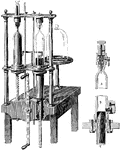
Kravogl's Air-pump
A machine designed to suppress the dead space which limits the efficiency of ordinary air-pumps.

Lace Machine
"A section of part of a lace machine. E is the cylinder or beam upon which the lace is rolled as made,…
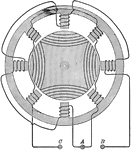
Altenating Current Motor
"...consists of a circular, multipolar field magnet, inclusing a cylinder armature with coils wound…

Nerves
"a, axis cylinder; b, inner border of white substance; c, c, outer border of same; d, d, tubular membrane;…
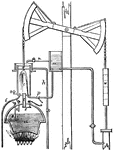
Newcomens Engine
"The simple outline of the atmospheric engine. Its mode of operation is as follows. Steam is admitted…
Oblique Prisms
Types of oblique prisms: right triangular prism, isosceles triangular prism, rectangular prism, cylinder.
Parallel Prisms
Types of parallel prisms: right triangular prism, isosceles triangular prism, rectangular prism, cylinder.
Conventional Breaks Symbols of Pipe or Tubing without Cutting Diameter
A shortcut drawing pipe or tubing conventional break to draw a pipes and tubes by shortening the length…

Piston and Barrel of Deleuil's Air-pump
"To avoid friction and heat, the piston is not in contact with the cylinder in which it works."

Pump
"The common pump consists of a hollow tube, the lower part of which, descending into the water, is called…

Frustum Of A Rectangular Pyramid With Hole
Illustration of a frustum of a pyramid having a rectangular base and a hole passing through the center…
Conventional Breaks Symbols of Round Section Cylinder
A conventional break symbol for a round section to use as a shortcut in shortening the length of the…
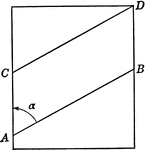
Spiral Drawn on Piece of Paper Shown Flat
Spiral with lines AB and CD drawn on piece of paper shown flat.

Spiral Drawn on Piece of Paper and Rolled
Spiral with lines AB and CD drawn on piece of paper and rolled into a cylinder to form spiral running…
Projection of Square Bar With Cylindrical Portion
Projection of a square bar with a cylindrical portion.

Striking Machine
"Striking machines are now very generally used for the operation. These consist of a drum or cylinder…
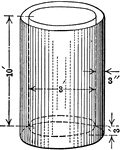
Cylindrical Water Tank
Cylindrical water tank with a height of 10 ft., thickness of 3 inches, and diameter of 3 feet. The diagram…

Torsion Balance
"ABCD is a cylinder of glass 1 foot in diameter and 1 foot high. This cylinder is closed by a glass…

Two Cylinders with Axes Not Intersecting
"If the cylinder A were to be developed a right section as at S—S would have to be taken, whose…

Intersection of Two Cylinders
"The intersection of two cylinders might represent a dome on a boiler. If the top view of cylinder A…
D Valve
"A valve for opening and closing the induction and eduction passages of a steam-engine cylinder: so…

D Valve
"A valve for opening and closing the induction and eduction passages of a steam-engine cylinder: so…

Wheel and Axle
"The wheel and axle consists of two cylinders of different diameters, rigidly connected, so that they…


